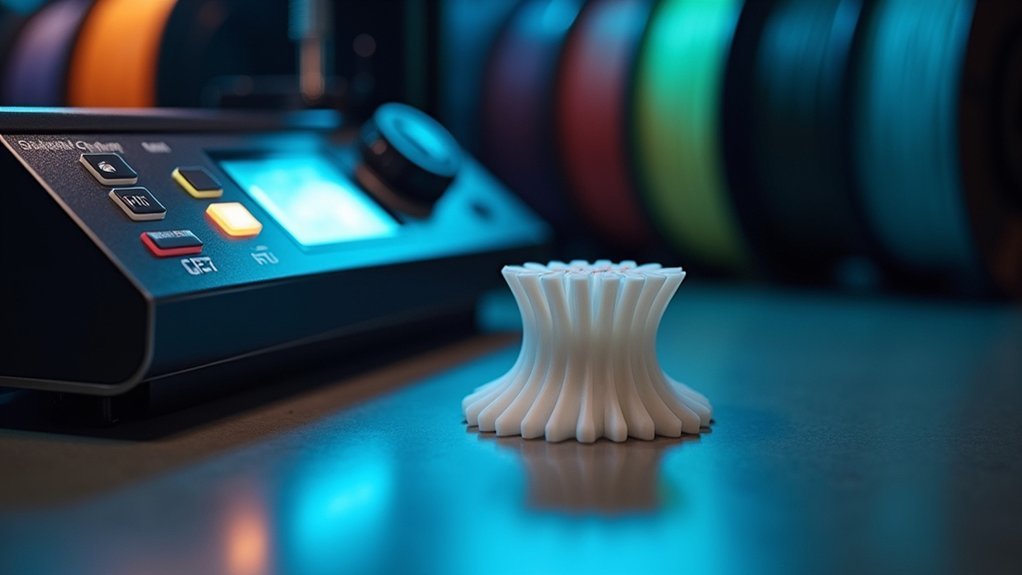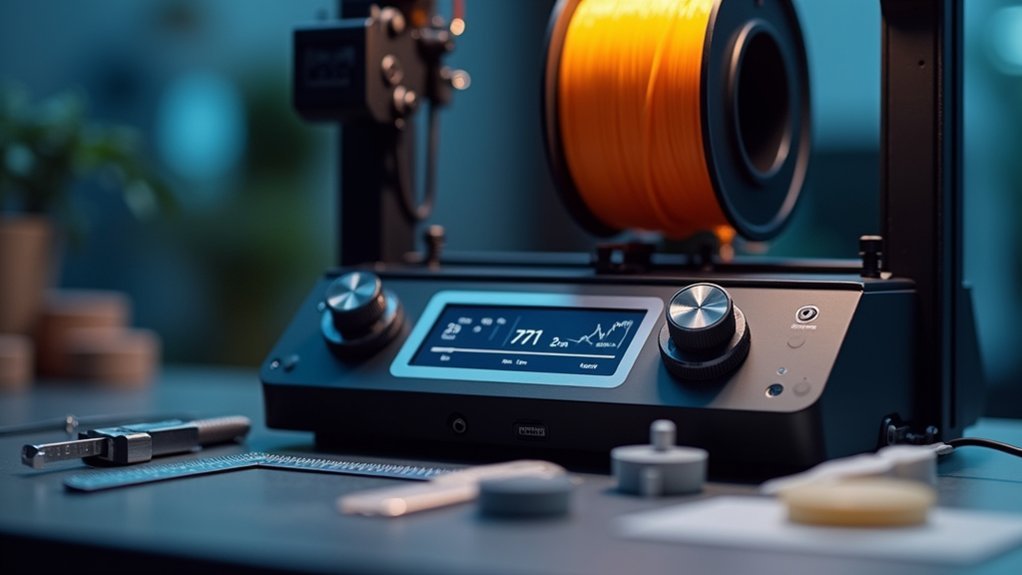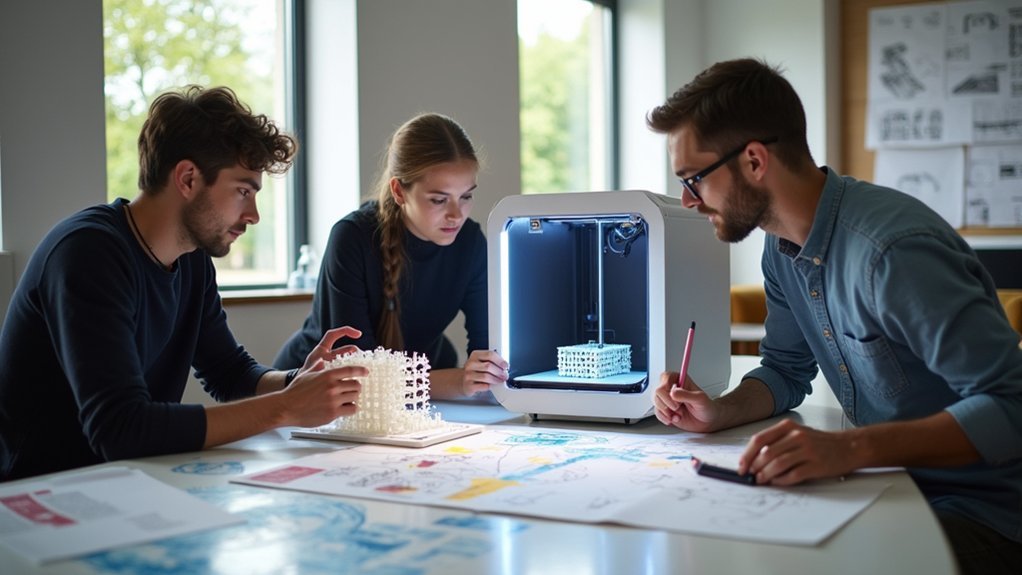You’ll achieve the best 3D printing results when your wall thickness is a precise multiple of your nozzle diameter, typically starting at 1.2mm for standard 0.4mm nozzles. Set your thickness to 2-3 times your layer height to prevent structural collapse, and adjust based on material—PLA works with thinner walls while ABS and flexible filaments need 2-3mm thickness. Test different multiples like 1.2mm, 1.6mm, and 2.0mm to find your ideal balance between strength and print time efficiency.
Understanding Wall Thickness in 3D Printing

Precision in 3D printing starts with understanding wall thickness—the critical distance between your object’s inner and outer surfaces that directly impacts your print’s strength, durability, and overall quality.
You’ll want to establish a minimum wall thickness of 1.2 mm for most projects, which should be 2-3 times your layer height to prevent structural collapse.
When you align your wall thickness with multiples of your nozzle diameter—like using 1.2 mm with a 0.4 mm nozzle—you’ll achieve three consistent wall lines and superior print quality.
Thicker walls greatly enhance structural integrity, reduce warping risks, and improve surface finishes.
For demanding applications, consider 2-3 mm thickness, while adjusting thinner walls in non-critical areas saves material and printing time.
The Relationship Between Nozzle Diameter and Wall Thickness
Your nozzle diameter directly determines how many wall lines you’ll need to achieve your desired wall thickness.
You can’t simply pick any wall thickness value – it must work mathematically with your nozzle size to avoid gaps or overlapping issues.
Understanding this relationship helps you calculate the ideal wall count and thickness ratios for stronger, more reliable prints.
Nozzle Size Fundamentals
When selecting wall thickness settings, understanding how your nozzle diameter directly affects print quality becomes essential for achieving strong, consistent results. Your nozzle size determines the baseline for calculating ideal wall thickness, as it controls the width of each deposited line of filament.
The fundamental relationship follows these key principles:
- Wall thickness should be a multiple of your nozzle diameter – ensuring complete wall lines without gaps
- Minimum recommended thickness is 0.8mm for 0.4mm nozzles – providing adequate structural integrity
- Extrusion width can exceed nozzle diameter by up to 200% – improving layer adhesion and bonding
For example, a 0.4mm nozzle with 1.2mm wall thickness creates three complete wall lines, while a 1mm nozzle achieves 2mm thickness with just two lines, greatly enhancing part strength.
Calculating Wall Count
Three mathematical factors determine your wall count calculation: nozzle diameter, desired wall thickness, and extrusion width.
Your Wall Line Count equals your Wall Thickness divided by the wall line width, which typically matches your nozzle diameter. For example, with a 0.4mm nozzle and 1.2mm Wall Thickness, you’ll get three wall lines (1.2 ÷ 0.4 = 3).
You’ll achieve ideal results when your Wall Thickness is a multiple of your nozzle diameter. A 1mm wall thickness with a 0.4mm nozzle creates 2.5 lines, leading to inconsistent extrusion. Instead, choose 1.2mm for three lines or 1.6mm for four lines.
Keep your Wall Thickness at least twice your nozzle diameter for structural integrity, with 0.8mm being the minimum for functional prints.
Optimal Thickness Ratios
Since nozzle diameter directly determines how much material you’ll extrude per pass, understanding ideal thickness ratios becomes essential for achieving consistent print quality.
Your wall thickness should always be a multiple of your nozzle diameter to avoid fractional lines that compromise dimensional accuracy.
For best results with a 0.4mm nozzle, consider these recommended ratios:
- 1.2mm thickness – Three wall lines providing reliable strength for standard parts
- 1.6mm thickness – Four wall lines when you need to print stronger components
- 2.0mm thickness – Five wall lines delivering maximum durability for demanding applications
Using 0.8mm thickness with a 0.4mm nozzle creates only two wall lines, often resulting in inconsistent quality.
When switching to larger nozzles like 0.6mm or 0.8mm, you can achieve the same wall thickness with fewer perimeters while maintaining structural integrity.
Calculating Perimeters and Wall Line Count
Precision becomes essential when calculating how many perimeters you’ll need for your desired wall thickness. You’ll divide your target thickness by the extrusion width to determine the correct wall line count. With a 0.4mm nozzle, your default extrusion width is typically 0.45mm.
| Wall Thickness | Wall Lines |
|---|---|
| 1.2mm | 3 |
| 1.8mm | 4 |
| 2.1mm | 5 |
For ideal results, choose wall thickness values that are multiples of your nozzle diameter. This guarantees your wall lines align perfectly, creating stronger prints with consistent quality. Remember that balancing wall thickness and wall line count affects your print’s strength, surface finish, and printing time. Always verify your calculations match your slicer’s settings for the best outcomes.
Material Considerations for Wall Thickness Selection

Your material choice directly impacts ideal wall thickness settings, as different filaments have varying strength and thermal properties that affect print quality.
You’ll need thinner walls for PLA compared to ABS, which requires extra thickness to compensate for its brittleness and prevent layer separation.
Flexible filaments demand considerably thicker walls (2-3mm) to maintain structural integrity, while high-temperature materials need careful thermal management to avoid overheating during printing.
PLA Vs ABS Requirements
When selecting wall thickness settings, the material you’re printing with fundamentally determines your approach.
PLA vs ABS requirements differ considerably due to their distinct thermal and structural properties. PLA’s lower melting point and superior layer adhesion allow you to use thinner walls while maintaining strength, whereas ABS demands thicker walls to counteract warping and thermal contraction.
Consider these key differences when setting wall thickness:
- PLA requires minimum 1.2mm walls with 0.4mm extrusion width for adequate strength
- ABS needs 2-3mm walls with wider extrusion widths up to 0.8mm for stability
- PLA maintains integrity at 1.6mm thickness while ABS requires 2mm minimum for stress resistance
These material-specific requirements directly impact print time, with ABS generally requiring longer printing periods due to thicker wall necessities.
Flexible Filament Thickness
Flexible filaments present unique challenges that require considerably thicker wall settings compared to rigid materials like PLA and ABS.
You’ll need at least 2-3mm wall thickness to maintain structural integrity and prevent deformation during printing and handling. Don’t go below 1.2mm minimum wall thickness, as thinner walls cause warping and compromise print quality due to the material’s inherent flexibility.
Increase your extrusion width to 0.6-0.8mm for ideal adhesion and strength without sacrificing quality.
You can customize wall thickness strategically—use thicker walls in critical stress areas while keeping lighter sections where strength isn’t essential. This approach maximizes material usage effectively.
Since different flexible filaments respond uniquely to thickness adjustments, you’ll need to test various settings to achieve ideal print performance for your specific material.
High-Temperature Material Settings
Since high-temperature materials like ABS and nylon generate significant thermal stress during printing, you’ll need substantially thicker walls to prevent warping and maintain structural integrity. These materials require a minimum wall thickness of 2-3 mm for ideal durability.
Configure your slicing software with these essential settings:
- Set wall thickness to at least 1.5 times your nozzle diameter
- Increase extrusion width up to 1.0 mm for enhanced layer bonding
- Reduce print speeds to allow proper cooling between layers
When working with high-temperature materials, experiment with different wall thickness configurations in your slicer to achieve better mechanical properties.
The combination of thicker walls and slower print speeds helps prevent overheating and deformation, ensuring your prints maintain dimensional accuracy throughout the cooling process.
Balancing Strength and Print Time Through Wall Settings

Although 3D printing offers tremendous design freedom, you’ll constantly face trade-offs between part strength and production efficiency when configuring wall thickness settings.
The standard recommendation of 1.2mm minimum wall thickness provides adequate durability for most applications, while three perimeters (roughly 1.3mm with 0.4mm nozzles) balance structural integrity and print time effectively.
You can enhance this balance by customizing settings for different model areas.
Critical structural zones benefit from thicker walls up to 2-3mm, while less important sections work fine with 0.8mm thickness.
This selective approach maximizes strength where needed without unnecessarily extending production time or material consumption.
Your slicing software’s wall customization features enable these targeted adjustments, helping you achieve peak performance without compromising efficiency throughout your entire print.
Minimum Wall Thickness Requirements by Application
Your application determines the minimum wall thickness you’ll need for successful prints.
Functional parts that’ll experience stress require thicker walls of 2-3 mm to maintain structural integrity, while decorative models can often get away with the standard 1.2 mm minimum.
You’ll want to match your wall thickness to how the part will be used rather than applying a one-size-fits-all approach.
Functional Parts Requirements
When printing functional parts that need to perform under real-world conditions, you’ll want to establish minimum wall thickness requirements based on your specific application.
Standard functional parts require at least 1.2mm wall thickness to guarantee structural integrity across most materials and printer capabilities.
For enhanced durability and mechanical stress resistance, consider these requirements:
- High-stress applications – Use 2-3mm wall thickness to prevent deformation under load
- Flexible materials – Implement 2-3mm thickness to minimize warping and maintain shape
- Threaded inserts – Calculate specific thickness needs, typically requiring minimum 2.1mm through multiple perimeters
High-precision functional parts need at least 0.8mm or twice your nozzle diameter to preserve dimensional accuracy and detail.
Always match your minimum wall thickness to the mechanical demands your parts will face during actual use.
Decorative Models Standards
Decorative models operate under vastly different requirements than functional parts, allowing you to refine for visual appeal rather than mechanical performance.
You’ll want to maintain a minimum wall thickness of 1.2mm for structural integrity while preserving fine details. For intricate designs requiring exceptional detail preservation, increase this to 1.6mm to enhance strength without sacrificing aesthetics.
When working with flexible materials, you’ll need 2-3mm wall thickness to prevent warping and maintain shape. Align your wall thickness with nozzle diameter multiples—1.2mm works perfectly with 0.4mm nozzles, creating three wall lines for ideal surface finish.
For functional decorative items like planters or boxes, use 2mm or thicker walls. This approach guarantees durability while handling without compromising the visual quality that thin walls provide.
Optimizing Wall Thickness for Different Printer Technologies
Since each 3D printing technology operates through different mechanisms, you’ll need to adjust your wall thickness settings accordingly to achieve ideal results.
Optimizing wall thickness for each 3D printing technology is essential for achieving maximum structural integrity and print quality.
For FDM printers, your wall thickness should be a multiple of your nozzle’s line width, with 0.8mm being the minimum recommendation for maximum strength and print quality.
Different technologies require specific considerations:
- SLA printers can handle thinner walls around 1mm due to their high resolution capabilities.
- SLS technology performs best with 1-3mm thickness to balance structural integrity and efficiency.
- DLP printers need at least 1.5mm to prevent warping during curing.
For binder jetting, aim for 2-3mm wall thickness to enhance mechanical properties while maintaining reliable printability across your projects.
Surface Quality Impact of Wall Thickness Choices
While thicker walls don’t automatically guarantee perfect prints, they’ll greatly improve your model’s surface quality by providing the structural foundation needed to prevent common defects.
When you increase wall thickness to at least 1.2mm, you’ll notice better dimensional accuracy and reduced warping that directly impacts surface finish.
Thicker walls particularly enhance overhangs and fine details by offering superior support during printing. Using three perimeters with a 0.4mm nozzle creates approximately 1.3mm thickness, delivering an excellent balance between strength and surface quality.
However, avoid excessive thickness that causes overheating and extended print times. These issues can actually compromise your surface quality despite the added material.
Finding the ideal wall thickness for each model guarantees you maximize surface quality benefits without introducing new problems.
Special Considerations for Vase Mode and Thin Wall Features
When you’re printing decorative objects or thin-walled prototypes, vase mode offers a unique printing approach that uses only a single perimeter to create seamless outer walls. This eliminates visible seams that multiple perimeters would create.
You can achieve thicker walls by increasing your external perimeter extrusion width—a 0.4mm nozzle can handle widths up to 0.8mm.
For thin wall features, modern slicers like Arachne wall generators let you print details thinner than your configured line width. However, you’ll need to follow these guidelines:
- Maintain minimum wall thickness to prevent collapsing
- Use wall thickness multiples of your nozzle diameter
- Test settings before final prints
These thin wall features enhance your model’s fidelity while ensuring structural integrity throughout the printing process.
Using Modifiers for Variable Wall Thickness
Although most prints benefit from uniform wall thickness, complex models often require strategic variation to enhance both strength and material usage. Modifiers in slicing software let you customize wall thickness in specific areas, enabling thicker walls for strength in critical regions and thinner walls where less material’s needed.
To set different perimeter counts with modifiers, divide your desired wall thickness by extrusion width. For example, targeting 2.1mm thickness with 0.45mm extrusion width requires five perimeters. This approach proves especially valuable for parts needing threaded inserts, where Perfect Wall Thickness is critical for proper fitting.
Always enable surface infill alongside modifiers to maintain structural integrity and tie perimeters into your model’s structure.
Consider your layer height when calculating total thickness requirements for ideal durability.
Troubleshooting Common Wall Thickness Issues
Even with careful planning, wall thickness settings can produce unexpected results that compromise print quality and structural integrity.
When you’re experiencing print failures, start by checking if your wall thickness is a proper multiple of your nozzle diameter—a 0.4mm nozzle needs at least 1.2mm thickness for three solid walls.
Monitor your extrusion width settings carefully, as exceeding the default perimeter width (typically 0.45mm for 0.4mm nozzles) causes overheating and uneven prints.
Use your slicer’s Detect Thin Walls feature to identify problematic areas before printing.
For persistent issues, follow this troubleshooting approach:
- Increase wall thickness incrementally by 0.2mm intervals
- Run test prints to validate each adjustment
- Apply targeted modifiers only to critical structural areas
This systematic method helps you balance strength requirements with material efficiency.
Advanced Slicer Features for Wall Optimization
While basic wall thickness adjustments solve most printing challenges, modern slicers offer sophisticated features that can dramatically improve your prints’ structural performance and surface quality.
The Arachne wall generator optimizes perimeter placement by intelligently adjusting wall counts based on your model’s geometry, while X-Y contour compensation corrects dimensional inaccuracies.
You can enhance wall strength by increasing external perimeter extrusion width up to 0.8mm with a 0.4mm nozzle. Configure minimum wall thickness and feature size settings to preserve critical details and prevent thin wall failures.
Use modifiers to create variable wall thickness throughout your model—applying thicker walls where strength matters most while conserving material elsewhere.
These advanced features let you fine-tune structural integrity without sacrificing print quality or efficiency.
Testing and Calibrating Your Wall Thickness Settings
Since every printer, filament, and project presents unique challenges, systematic testing becomes your most reliable path to perfect wall thickness settings.
Start by conducting test prints with varying wall thicknesses, ensuring each setting is a multiple of your nozzle diameter. For a 0.4mm nozzle, test at 1.2mm, 1.6mm, and 2.0mm thicknesses.
Follow this testing approach:
- Print identical test models with different wall thickness settings
- Evaluate each print’s strength by testing structural integrity and dimensional accuracy
- Document your results including material type, settings used, and performance notes
Use your slicer’s contour compensation features to fine-tune critical areas requiring extra strength.
This documentation becomes invaluable for future projects, helping you quickly select optimal settings based on proven results rather than guesswork.
Frequently Asked Questions
What Should Wall Thickness Be in Cura?
You should set wall thickness to at least 1.2mm for standard prints, but use 1.6mm or higher for stronger parts. Always make it a multiple of your nozzle diameter for best results.
How to Decide Wall Thickness?
You’ll decide wall thickness by multiplying your nozzle diameter by three for basic strength. Consider your part’s stress requirements, material type, and print quality needs to determine if you need thicker walls.
What Should My Wall Thickness Be?
You should use 1.2mm wall thickness as your starting point, which equals three wall lines with a 0.4mm nozzle. Increase to 2-3mm for parts needing extra strength or durability.
How to Select Pipe Wall Thickness?
You’ll need to calculate required thickness by dividing desired thickness by extrusion width, make certain it’s a multiple of your nozzle diameter, and use modifiers for reinforcement in high-stress areas.





Leave a Reply